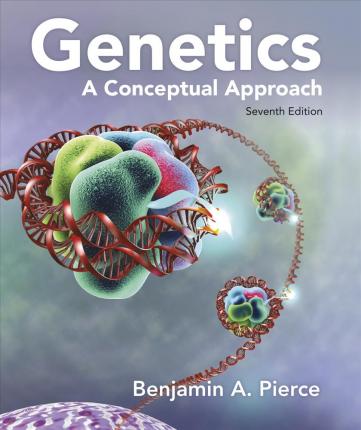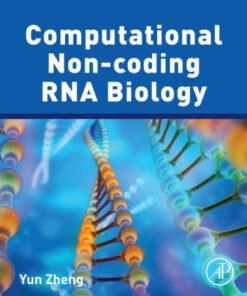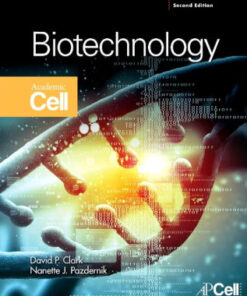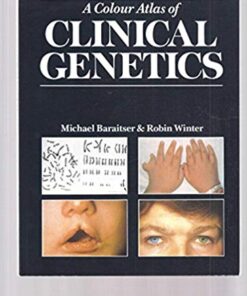(eBook) Genetics – A Conceptual Approach 7th Edition by Pierce
$32.00
Download instantly Genetics – A Conceptual Approach 7th Edition by Benjamin A. Pierce. It is ebook in PDF format.
ISBN-10: 1319216803 ISBN-13: 9781319216801
Preview
This is the PDF eBook version for Genetics – A Conceptual Approach 7th Edition by Benjamin A. Pierce
Table of Contents
Preface
New and Reorganized Content
Acknowledgments
Half-Title Page
Chapter 1 Introduction to Genetics
1.1 Genetics Is Important to Us Individually, to Society, and to the Study of Biology
The Role of Genetics in Biology
Genetic Diversity and Evolution
DNA in the Biosphere
Divisions of Genetics
Model Genetic Organisms
1.2 Humans Have Been Using Genetic Techniques for Thousands of Years
The Early Use and Understanding of Heredity
The Rise of the Science of Genetics
The Cutting Edge of Genetics
1.3 A Few Fundamental Concepts Are Important for the Start of Our Journey into Genetics
Chapter 1 Review
Chapter Summary
Important Terms
Answers to Concept Checks
Chapter 1 Assessment
Comprehension Questions
Application Questions and Problems
Challenge Questions
Active Learning: Think-Pair-Share Questions
Active Learning: Concept Mapping Exercises
Chapter 2 Chromosomes and Cellular Reproduction
2.1 Prokaryotic and Eukaryotic Cells Differ in a Number of Genetic Characteristics
2.2 Cell Reproduction Requires the Copying of the Genetic Material, Separation of the Copies, and Cell Division
Prokaryotic Cell Reproduction by Binary Fission
Eukaryotic Cell Reproduction
The Cell Cycle and Mitosis
Genetic Consequences of the Cell Cycle
2.3 Sexual Reproduction Produces Genetic Variation Through the Process of Meiosis
Meiosis
Sources of Genetic Variation in Meiosis
The Separation of Sister Chromatids and Homologous Chromosomes
Meiosis in the Life Cycles of Animals and Plants
Chapter 2 Review
Chapter Summary
Worked Problems
Important Terms
Answers to Concept Checks
Chapter 2 Assessment
Comprehension Questions
Application Questions and Problems
Challenge Questions
Active Learning: Think-Pair-Share Questions
Active Learning: Concept Mapping Exercises
Chapter 3 Basic Principles of Heredity
3.1 Gregor Mendel Discovered the Basic Principles of Heredity
Mendel’s Success
Genetic Terminology
3.2 Monohybrid Crosses Reveal the Principle of Segregation and the Concept of Dominance
What Monohybrid Crosses Reveal
The Molecular Nature of Alleles
Predicting the Outcomes of Genetic Crosses
The Testcross
Genetic Symbols
3.3 Dihybrid Crosses Reveal the Principle of Independent Assortment
Dihybrid Crosses
The Principle of Independent Assortment
Relating the Principle of Independent Assortment to Meiosis
Applying Probability and the Branch Diagram to Dihybrid Crosses
The Dihybrid Testcross
3.4 Observed Ratios of Progeny May Deviate from Expected Ratios by Chance
The Chi-Square (χ2) Goodness-of-Fit Test
Chapter 3 Review
Chapter Summary
Worked Problems
Important Terms
Answers to Concept Checks
Chapter 3 Assessment
Comprehension Questions
Application Questions and Problems
Challenge Questions
Active Learning: Think-Pair-Share Questions
Active Learning: Concept Mapping Exercises
Chapter 4 Sex Determination and Sex-Linked Characteristics
4.1 Sex Is Determined by a Number of Different Mechanisms
Chromosomal Sex-Determining Systems
Genic Sex Determination
Environmental Sex Determination
Sex Determination in Drosophila melanogaster
Sex Determination in Humans
4.2 Sex-Linked Characteristics Are Determined by Genes on the Sex Chromosomes
X-Linked White Eyes in Drosophila
Nondisjunction and the Chromosome Theory of Inheritance
X-Linked Color Blindness in Humans
Symbols for X-Linked Genes
Z-Linked Characteristics
Y-Linked Characteristics
4.3 Dosage Compensation Equalizes the Amount of Protein Produced by X-Linked and Autosomal Genes in Some Animals
The Lyon Hypothesis
Mechanism of Random X Inactivation
Chapter 4 Review
Chapter Summary
Worked Problems
Important Terms
Answers to Concept Checks
Chapter 4 Assessment
Comprehension Questions
Application Questions and Problems
Challenge Questions
Active Learning: Think-Pair-Share Questions
Active Learning: Concept Mapping Exercises
Chapter 5 Extensions and Modifications of Basic Principles
5.1 Additional Factors at a Single Locus Can Affect the Results of Genetic Crosses
Types of Dominance
Penetrance and Expressivity
Lethal Alleles
Multiple Alleles
5.2 Gene Interaction Takes Place When Genes at Multiple Loci Determine a Single Phenotype
Gene Interaction That Produces Novel Phenotypes
Gene Interaction with Epistasis
Complementation: Determining Whether Mutations Are at the Same Locus or at Different Loci
The Complex Genetics of Coat Color in Dogs
5.3 Sex Influences the Inheritance and Expression of Genes in a Variety of Ways
Sex-Influenced and Sex-Limited Characteristics
Cytoplasmic Inheritance
Genetic Maternal Effect
Genomic Imprinting
5.4 Anticipation Is the Stronger or Earlier Expression of Traits in Succeeding Generations
5.5 Phenotypes May Be Influenced by Environmental Factors and Multiple Genes
Environmental Effects on the Phenotype
The Inheritance of Continuous Characteristics
Chapter 5 Review
Chapter Summary
Worked Problems
Important Terms
Answers to Concept Checks
Chapter 5 Assessment
Comprehension Questions
Application Questions and Problems
Challenge Questions
Active Learning: Think-Pair-Share Questions
Active Learning: Concept Mapping Exercises
Chapter 6 Pedigree Analysis, Applications, and Genetic Testing
6.1 The Study of Genetics in Humans Is Constrained by Special Features of Human Biology and Culture
6.2 Geneticists Often Use Pedigrees to Study the Inheritance of Characteristics in Humans
Symbols Used in Pedigrees
Analysis of Pedigrees
Autosomal Recessive Traits
Autosomal Dominant Traits
X-Linked Recessive Traits
X-Linked Dominant Traits
Y-Linked Traits
Genetic Mosaicism
6.3 Studying Twins and Adoptions Can Help Assess the Importance of Genes and Environment
Types of Twins
Concordance in Twins
A Twin Study of Asthma
Adoption Studies
6.4 Genetic Counseling and Genetic Testing Provide Information to Those Concerned about Genetic Diseases and Traits
Genetic Counseling
Genetic Testing
Interpreting Genetic Tests
Direct-to-Consumer Genetic Testing
Genealogies and Genetic Testing for Ancestry
Genetic Discrimination and Privacy
Chapter 6 Review
Chapter Summary
Worked Problems
Important Terms
Answers to Concept Checks
Chapter 6 Assessment
Comprehension Questions
Application Questions and Problems
Challenge Questions
Active Learning: Think-Pair-Share Questions
Active Learning: Concept Mapping Exercises
Chapter 7 Linkage, Recombination, and Eukaryotic Gene Mapping
7.1 Linked Genes Do Not Assort Independently
7.2 Linked Genes Segregate Together While Crossing Over Produces Recombination Between Them
Notation for Crosses with Linkage
Complete Linkage Compared with Independent Assortment
Crossing Over Between Linked Genes
Calculating Recombination Frequency
Coupling and Repulsion
Evidence for the Physical Basis of Recombination
Predicting the Outcomes of Crosses with Linked Genes
Testing for Independent Assortment
Gene Mapping with Recombination Frequencies
Constructing a Genetic Map with a Two-Point Testcross
7.3 A Three-Point Testcross Can Be Used to Map Three Linked Genes
Constructing a Genetic Map with a Three-Point Testcross
Effects of Multiple Crossovers
Mapping Human Genes
Mapping with Molecular Markers
Locating Genes with Genome-Wide Association Studies
7.4 Physical-Mapping Methods Are Used to Determine the Physical Positions of Genes on Particular Chromosomes
Somatic-Cell Hybridization
Deletion Mapping
Physical Chromosome Mapping Through Molecular Analysis
7.5 Recombination Rates Exhibit Extensive Variation
Chapter 7 Review
Chapter Summary
Worked Problems
Important Terms
Answers to Concept Checks
Chapter 7 Assessment
Comprehension Questions
Application Questions and Problems
Challenge Questions
Active Learning: Think-Pair-Share Questions
Active Learning: Concept Mapping Exercises
Chapter 8 Chromosome Variation
8.1 Chromosome Mutations Include Rearrangements, Aneuploidy, and Polyploidy
Chromosome Morphology
Types of Chromosome Mutations
8.2 Chromosome Rearrangements Alter Chromosome Structure
Duplications
Deletions
Inversions
Translocations
Fragile Sites
Copy-Number Variations
8.3 Aneuploidy Is an Increase or Decrease in the Number of Individual Chromosomes
Types of Aneuploidy
Effects of Aneuploidy
Aneuploidy in Humans
Uniparental Disomy
Genetic Mosaicism
8.4 Polyploidy Is the Presence of More Than Two Sets of Chromosomes
Autopolyploidy
Allopolyploidy
The Significance of Polyploidy
Chapter 8 Review
Chapter Summary
Worked Problems
Important Terms
Answers to Concept Checks
Chapter 8 Assessment
Comprehension Questions
Application Questions and Problems
Challenge Questions
Active Learning: Think-Pair-Share Questions
Active Learning: Concept Mapping Exercises
Chapter 9 Bacterial and Viral Genetic Systems
9.1 Bacteria and Viruses Have Important Roles in Human Society and the World Ecosystem
Life in a Bacterial World
Bacterial Diversity
9.2 Genetic Analysis of Bacteria Requires Special Methods
Techniques for the Study of Bacteria
The Bacterial Genome
Plasmids
9.3 Bacteria Exchange Genes Through Conjugation, Transformation, and Transduction
Conjugation
Natural Gene Transfer and Antibiotic Resistance
Transformation in Bacteria
Bacterial Genome Sequences
Horizontal Gene Transfer
9.4 Bacterial Defense Mechanisms
Restriction-Modification Systems
CRISPR-Cas Systems
An Evolutionary Arms Race Between Bacteria and Viruses
9.5 Viruses Are Simple Replicating Systems Amenable to Genetic Analysis
Techniques for the Study of Bacteriophages
Transduction
Gene Mapping in Phages
Plant and Animal Viruses
Human Immunodeficiency Virus and AIDS
Influenza
Rhinoviruses
Zika Virus
Chapter 9 Review
Chapter Summary
Worked Problems
Important Terms
Answers to Concept Checks
Chapter 9 Assessment
Comprehension Questions
Application Questions and Problems
Challenge Question
Active Learning: Think-Pair-Share Questions
Active Learning: Concept Mapping Exercises
Chapter 10 DNA: The Chemical Nature of the Gene
10.1 Genetic Material Possesses Several Key Characteristics
10.2 All Genetic Information Is Encoded in the Structure of DNA or RNA
Early Studies of DNA
DNA as the Source of Genetic Information
Watson and Crick’s Discovery of the Three-Dimensional Structure of DNA
RNA as Genetic Material
10.3 DNA Consists of Two Complementary and Antiparallel Nucleotide Strands That Form a Double Helix
The Primary Structure of DNA
Secondary Structures of DNA
10.4 Special Structures Can Form in DNA and RNA
Chapter 10 Review
Chapter Summary
Worked Problems
Important Terms
Answers to Concept Checks
Chapter 10 Assessment
Comprehension Questions
Application Questions and Problems
Challenge Questions
Active Learning: Think-Pair-Share Questions
Active Learning: Concept Mapping Exercises
Chapter 11 Chromosome Structure and Organelle DNA
11.1 Large Amounts of DNA Are Packed into a Cell
Supercoiling
The Bacterial Chromosome
Eukaryotic Chromosomes
Changes in Chromatin Structure
11.2 Eukaryotic Chromosomes Possess Centromeres and Telomeres
Centromere Structure
Telomere Structure
11.3 Eukaryotic DNA Contains Several Classes of Sequence Variation
The Denaturation and Renaturation of DNA
Types of DNA Sequences in Eukaryotes
Organization of Genetic Information in Eukaryotes
11.4 Organelle DNA Has Unique Characteristics
Mitochondrion and Chloroplast Structure
The Endosymbiotic Theory
Uniparental Inheritance of Organelle-Encoded Traits
The Mitochondrial Genome
The Evolution of Mitochondrial DNA
Damage to Mitochondrial DNA Associated with Aging
Mitochondrial Replacement Therapy
The Chloroplast Genome
Movement of Genetic Information Between Nuclear, Mitochondrial, and Chloroplast Genomes
Chapter 11 Review
Chapter Summary
Worked Problems
Important Terms
Answers to Concept Checks
Chapter 11 Assessment
Comprehension Questions
Application Questions and Problems
Challenge Questions
Active Learning: Think-Pair-Share Questions
Active Learning: Concept Mapping Exercises
Chapter 12 DNA Replication and Recombination
12.1 Genetic Information Must Be Accurately Copied Every Time a Cell Divides
12.2 All DNA Replication Takes Place in a Semiconservative Manner
Meselson and Stahl’s Experiment
Modes of Replication
Requirements of Replication
Direction of Replication
12.3 Bacterial Replication Requires a Large Number of Enzymes and Proteins
Initiation
Unwinding
Elongation
Termination
The Fidelity of DNA Replication
12.4 Eukaryotic DNA Replication Is Similar to Bacterial Replication but Differs in Several Aspects
Eukaryotic Origins of Replication
DNA Synthesis and the Cell Cycle
The Licensing of DNA Replication
Unwinding
Eukaryotic DNA Polymerases
Nucleosome Assembly
The Location of Replication Within the Nucleus
Replication at the Ends of Chromosomes
Replication in Archaea
12.5 Recombination Takes Place Through the Alignment, Breakage, and Repair of DNA Strands
Models of Recombination
Enzymes Required for Recombination
Chapter 12 Review
Chapter Summary
Worked Problems
Important Terms
Answers to Concept Checks
Chapter 12 Assessment
Comprehension Questions
Application Questions and Problems
Challenge Questions
Active Learning: Think-Pair-Share Questions
Active Learning: Concept Mapping Exercises
Chapter 13 Transcription
13.1 RNA, Consisting of a Single Strand of Ribonucleotides, Participates in a Variety of Cellular Functions
An Early RNA World
The Structure of RNA
Classes of RNA
13.2 Transcription Is the Synthesis of an RNA Molecule from a DNA Template
The Template
The Substrate for Transcription
The Transcription Apparatus
13.3 Bacterial Transcription Consists of Initiation, Elongation, and Termination
Initiation
Elongation
Termination
13.4 Eukaryotic Transcription Is Similar to Bacterial Transcription but Has Some Important Differences
Transcription and Nucleosome Structure
Promoters
Initiation
Elongation
Termination
13.5 Transcription in Archaea Is More Similar to Transcription in Eukaryotes Than to Transcription in Bacteria
Chapter 13 Review
Chapter Summary
Worked Problems
Important Terms
Answers to Concept Checks
Chapter 13 Assessment
Comprehension Questions
Application Questions and Problems
Challenge Questions
Active Learning: Think-Pair-Share Questions
Active Learning: Concept Mapping Exercises
Chapter 14 RNA Molecules and RNA Processing
14.1 Many Genes Have Complex Structures
Gene Organization
Introns
The Concept of the Gene Revisited
14.2 Messenger RNAs, Which Encode Proteins, Are Modified after Transcription in Eukaryotes
The Structure of Messenger RNA
Pre-mRNA Processing
RNA Splicing
Alternative Processing Pathways
RNA Editing
14.3 Transfer RNAs, Which Attach to Amino Acids, Are Modified after Transcription in Bacterial and Eukaryotic Cells
The Structure of Transfer RNA
Transfer RNA Gene Structure and Processing
14.4 Ribosomal RNA, a Component of the Ribosome, Is Also Processed after Transcription
The Structure of the Ribosome
Ribosomal RNA Gene Structure and Processing
14.5 Small RNA Molecules Participate in a Variety of Functions
RNA Interference
Small Interfering RNAs and MicroRNAs
Piwi-Interacting RNAs
CRISPR RNA
14.6 Long Noncoding RNAs Regulate Gene Expression
Chapter 14 Review
Chapter Summary
Worked Problems
Important Terms
Answers to Concept Checks
Chapter 14 Assessment
Comprehension Questions
Application Questions and Problems
Challenge Questions
Active Learning: Think-Pair-Share Questions
Active Learning: Concept Mapping Exercises
Chapter 15 The Genetic Code and Translation
15.1 Many Genes Encode Proteins
The One Gene, One Enzyme Hypothesis
The Structure and Function of Proteins
15.2 The Genetic Code Determines How the Nucleotide Sequence Specifies the Amino Acid Sequence of a Protein
Breaking the Genetic Code
The Degeneracy of the Code
The Reading Frame and Initiation Codons
Termination Codons
The Universality of the Code
15.3 Amino Acids Are Assembled into a Protein Through Translation
The Binding of Amino Acids to Transfer RNAs
The Initiation of Translation
Elongation
Termination
15.4 Additional Properties of RNA and Ribosomes Affect Protein Synthesis
The Three-Dimensional Structure of the Ribosome
Polyribosomes
Messenger RNA Surveillance
Folding and Posttranslational Modifications of Proteins
Translation and Antibiotics
Chapter 15 Review
Chapter Summary
Worked Problems
Important Terms
Answers to Concept Checks
Chapter 15 Assessment
Comprehension Questions
Application Questions and Problems
Challenge Questions
Active Learning: Think-Pair-Share Questions
Active Learning: Concept Mapping Exercises
Chapter 16 Control of Gene Expression in Bacteria
16.1 The Regulation of Gene Expression Is Critical for All Organisms
Genes and Regulatory Elements
Levels of Gene Regulation
DNA-Binding Proteins
16.2 Transcription in Bacterial Cells Is Regulated by Operons
Operon Structure
Negative and Positive Control: Inducible and Repressible Operons
The lac Operon of E. coli
lac Mutations
Positive Control and Catabolite Repression
The trp Operon of E. coli
16.3 Some Operons Regulate Transcription Through Attenuation, the Premature Termination of Transcription
Attenuation in the trp Operon of E. coli
Why Does Attenuation Take Place in the trp Operon?
16.4 Other Sequences Control the Expression of Some Bacterial Genes
Bacterial Enhancers
Antisense RNA
Riboswitches
RNA-Mediated Repression Through Ribozymes
Chapter 16 Review
Chapter Summary
Worked Problems
Important Terms
Answers to Concept Checks
Chapter 16 Assessment
Comprehension Questions
Application Questions and Problems
Challenge Questions
Active Learning: Think-Pair-Share Questions
Active Learning: Concept Mapping Exercises
Chapter 17 Control of Gene Expression in Eukaryotes
17.1 Eukaryotic Cells and Bacteria Share Many Features of Gene Regulation but Differ in Several Important Ways
17.2 Changes in Chromatin Structure Affect the Expression of Eukaryotic Genes
DNase I Hypersensitivity
Chromatin Remodeling
Histone Modification
DNA Methylation
17.3 Transcription Is Regulated by Transcription Factors
Transcription Factors
Enhancers and Silencers
Insulators and Regulatory Neighborhoods
Regulation of Transcriptional Stalling and Elongation
Coordinated Gene Regulation
17.4 Eukaryotic Genes Are Regulated by RNA Processing and Degradation
Gene Regulation Through RNA Splicing
The Degradation of RNA
17.5 RNA Interference Is an Important Mechanism of Gene Regulation
Small Interfering RNAs and MicroRNAs
Mechanisms of Gene Regulation by RNA Interference
The Control of Development by RNA Interference
RNA Crosstalk
17.6 The Expression of Some Genes Is Regulated by Processes That Affect Translation or by Modifications of Proteins
Chapter 17 Review
Chapter Summary
Worked Problems
Important Terms
Answers to Concept Checks
Chapter 17 Assessment
Comprehension Questions
Application Questions and Problems
Challenge Questions
Active Learning: Think-Pair-Share Questions
Active Learning: Concept Mapping Exercises
Chapter 18 Gene Mutations and DNA Repair
18.1 Mutations Are Inherited Alterations in the DNA Sequence
The Importance of Mutations
Categories of Mutations
Types of Gene Mutations
Functional Effects of Mutations
Suppressor Mutations
Mutation Rates
18.2 Mutations May Be Caused by a Number of Different Factors
Spontaneous Replication Errors
Spontaneous Chemical Changes
Chemically Induced Mutations
Radiation
18.3 Mutations Are the Focus of Intense Study by Geneticists
Detecting Mutagens with the Ames Test
Effects of Radiation Exposure in Humans
18.4 Transposable Elements Can Cause Mutations
General Characteristics of Transposable Elements
The Process of Transposition
The Mutagenic Effects of Transposition
Transposable Elements in Bacteria
Transposable Elements in Eukaryotes
Transposable Elements in Genome Evolution
18.5 A Number of Pathways Can Repair DNA
Mismatch Repair
Direct Repair
Base-Excision Repair
Nucleotide-Excision Repair
Repair of Double-Strand Breaks
Translesion DNA Polymerases
Genetic Diseases and Faulty DNA Repair
Chapter 18 Review
Chapter Summary
Worked Problems
Important Terms
Answers to Concept Checks
Chapter 18 Assessment
Comprehension Questions
Application Questions and Problems
Challenge Questions
Active Learning: Think-Pair-Share Questions
Active Learning: Concept Mapping Exercises
Chapter 19 Molecular Genetic Analysis and Biotechnology
19.1 Genetics Has Been Transformed by the Development of Molecular Techniques
Key Innovations in Molecular Genetics
Working at the Molecular Level
19.2 Molecular Techniques Are Used to Cut and Visualize DNA Sequences
Recombinant DNA Technology
Restriction Enzymes
Engineered Nucleases
CRISPR-Cas Genome Editing
Separating and Viewing DNA Fragments
Locating DNA Fragments with Probes
19.3 Specific DNA Fragments Can Be Amplified
The Polymerase Chain Reaction
Gene Cloning
19.4 Molecular Techniques Can Be Used to Find Genes of Interest
DNA Libraries
In Situ Hybridization
Positional Cloning
19.5 DNA Sequences Can Be Determined and Analyzed
Dideoxy Sequencing
Next-Generation Sequencing Technologies
DNA Fingerprinting
19.6 Molecular Techniques Are Increasingly Used to Analyze Gene Function
Forward and Reverse Genetics
Creating Random Mutations
Targeted Mutagenesis
Transgenic Animals
Knockout Mice
Silencing Genes with RNAi
Using RNAi to Treat Human Disease
19.7 Biotechnology Harnesses the Power of Molecular Genetics
Pharmaceutical Products
Specialized Bacteria
Agricultural Products
Genetic Testing
Gene Therapy
Chapter 19 Review
Chapter Summary
Worked Problems
Important Terms
Answers to Concept Checks
Chapter 19 Assessment
Comprehension Questions
Application Questions and Problems
Challenge Question
Active Learning: Think-Pair-Share Questions
Active Learning: Concept Mapping Exercises
Chapter 20 Genomics and Proteomics
20.1 Structural Genomics Determines the DNA Sequences and Organization of Entire Genomes
Genetic Maps
Physical Maps
Sequencing an Entire Genome
The Human Genome Project
What Exactly Is the Human Genome?
Single-Nucleotide Polymorphisms
Bioinformatics
Metagenomics
Synthetic Biology
20.2 Functional Genomics Determines the Functions of Genes by Using Genomic Approaches
Predicting Function from Sequence
Gene Expression
Gene Expression and Reporter Sequences
Genome-Wide Mutagenesis
20.3 Comparative Genomics Studies How Genomes Evolve
Prokaryotic Genomes
Eukaryotic Genomes
The Human Genome
20.4 Proteomics Analyzes the Complete Set of Proteins Found in a Cell
Determination of Cellular Proteins
Affinity Capture
Protein Microarrays
Structural Proteomics
Chapter 20 Review
Chapter Summary
Worked Problem
Important Terms
Answers to Concept Checks
Chapter 20 Assessment
Comprehension Questions
Application Questions and Problems
Challenge Questions
Active Learning: Think-Pair-Share Questions
Active Learning: Concept Mapping Exercises
Chapter 21 Epigenetics
21.1 What Is Epigenetics?
21.2 Several Molecular Processes Lead to Epigenetic Changes
DNA Methylation
Histone Modifications
Epigenetic Effects of RNA Molecules
21.3 Epigenetic Processes Affect Development
Epigenetic Changes Associated with Cell Differentiation
Transgenerational Effects Through Paramutation
X Inactivation
Genomic Imprinting
Epigenetic Effects in Monozygotic Twins
21.4 Epigenetic Alterations Bring about Changes in Behavior, Reproduction, and Metabolism
Behavioral Epigenetics
Epigenetic Effects of Environmental Chemicals
Epigenetic Effects on Metabolism
21.5 The Epigenome
Chapter 21 Review
Chapter Summary
Worked Problem
Important Terms
Answers to Concept Checks
Chapter 21 Assessment
Comprehension Questions
Application Questions and Problems
Challenge Question
Active Learning: Think-Pair-Share Questions
Active Learning: Concept Mapping Exercises
Chapter 22 Developmental Genetics and Immunogenetics
22.1 Development Takes Place Through Cell Determination
Cloning Experiments on Plants
Cloning Experiments on Animals
22.2 Pattern Formation in Drosophila Serves as a Model for the Genetic Control of Development
The Development of the Fruit Fly
Egg-Polrity Genes
Segmentation Genes
Homeotic Genes in Drosophila
Homeobox Genes in Other Organisms
Epigenetic Changes in Development
Mapping Gene Expression in Drosophila Embryos
22.3 Genes Control the Development of Flowers in Plants
Flower Anatomy
Genetic Control of Flower Development
22.4 Programmed Cell Death Is an Integral Part of Development
22.5 The Study of Development Reveals Patterns and Processes of Evolution
22.6 The Development of Immunity Occurs Through Genetic Rearrangement
The Organization of the Immune System
Immunoglobulin Structure
The Generation of Antibody Diversity
T-Cell-Receptor Diversity
Major Histocompatibility Complex Genes
Genes and Organ Transplants
Chapter 22 Review
Chapter Summary
Worked Problems
Important Terms
Answers to Concept Checks
Chapter 22 Assessment
Comprehension Questions
Application Questions and Problems
Challenge Question
Active Learning: Think-Pair-Share Questions
Active Learning: Concept Mapping Exercises
Chapter 23 Cancer Genetics
23.1 Cancer Is a Group of Diseases Characterized by Cell Proliferation
Tumor Formation
Cancer as a Genetic Disease
The Role of Environmental Factors in Cancer
23.2 Mutations in Several Types of Genes Contribute to Cancer
Oncogenes and Tumor-Suppressor Genes
Genes That Control the Cell Cycle
DNA-Repair Genes
Genes That Regulate Telomerase
Genes That Promote Vascularization and the Spread of Tumors
MicroRNAs and Cancer
Cancer Genome Projects
23.3 Epigenetic Changes Are Often Associated with Cancer
23.4 Colorectal Cancer Arises Through the Sequential Mutation of a Number of Genes
23.5 Changes in Chromosome Number and Structure Are Often Associated with Cancer
23.6 Viruses Are Associated with Some Cancers
Retroviruses and Cancer
Human Papillomavirus and Cervical Cancer
Chapter 23 Review
Chapter Summary
Worked Problem
Important Terms
Answers to Concept Checks
Chapter 23 Assessment
Comprehension Questions
Application Questions and Problems
Challenge Questions
Active Learning: Think-Pair-Share Questions
Active Learning: Concept Mapping Exercises
Chapter 24 Quantitative Genetics
24.1 Quantitative Characteristics Are Influenced by Alleles at Multiple Loci
The Relation Between Genotype and Phenotype
Types of Quantitative Characteristics
Polygenic Inheritance
Kernel Color in Wheat
Determining Gene Number for a Polygenic Characteristic
24.2 Statistical Methods Are Required for Analyzing Quantitative Characteristics
Distributions
Samples and Populations
The Mean
The Variance and Standard Deviation
Correlation
Regression
Worked Problem
Applying Statistics to the Study of a Polygenic Characteristic
24.3 Heritability Is Used to Estimate the Proportion of Variation in a Trait That Is Genetic
Phenotypic Variance
Types of Heritability
Calculating Heritability
The Limitations of Heritability
Locating Genes That Affect Quantitative Characteristics
24.4 Genetically Variable Traits Change in Response to Selection
Predicting the Response to Selection
Limits to the Response to Selection
Correlated Responses to Selection
Chapter 24 Review
Chapter Summary
Worked Problems
Important Terms
Answers to Concept Checks
Chapter 24 Assessment
Comprehension Questions
Application Questions and Problems
Challenge Questions
Active Learning: Think-Pair-Share Questions
Active Learning: Concept Mapping Exercises
Chapter 25 Population Genetics
25.1 Genotypic and Allelic Frequencies Are Used to Describe the Gene Pool of a Population
Mathematical Models for Understanding Genetic Variation
Calculating Genotypic Frequencies
Calculating Allelic Frequencies
Worked Problem
25.2 The Hardy–Weinberg Law Describes the Effect of Reproduction on Genotypic and Allelic Frequencies
Genotypic Frequencies at Hardy–Weinberg Equilibrium
Closer Examination of the Hardy–Weinberg Law
Implications of the Hardy–Weinberg Law
Extensions of the Hardy–Weinberg Law
Testing for Hardy–Weinberg Proportions
Worked Problem
Estimating Allelic Frequencies with the Hardy–Weinberg Law
25.3 Nonrandom Mating Affects the Genotypic Frequencies of a Population
25.4 Several Evolutionary Forces Can Change Allelic Frequencies
Mutation
Migration
Genetic Drift
Natural Selection
Worked Problem
Chapter 25 Review
Chapter Summary
Worked Problem
Important Terms
Answers to Concept Checks
Chapter 25 Assessment
Comprehension Questions
Application Questions and Problems
Challenge Questions
Active Learning: Think-Pair-Share Questions
Active Learning: Concept Mapping Exercises
Chapter 26 Evolutionary Genetics
26.1 Evolution Occurs Through Genetic Change Within Populations
Biological Evolution
Evolution as a Two-Step Process
Evolution in Bighorn Sheep
26.2 Many Natural Populations Contain High Levels of Genetic Variation
Molecular Variation
26.3 New Species Arise Through the Evolution of Reproductive Isolation
The Biological Species Concept
Reproductive Isolating Mechanisms
Modes of Speciation
Genetic Differentiation Associated with Speciation
26.4 The Evolutionary History of a Group of Organisms Can Be Reconstructed by Studying Changes in Homologous Characteristics
Interpreting Phylogenetic Trees
The Alignment of Homologous Sequences
The Construction of Phylogenetic Trees
26.5 Patterns of Evolution Are Revealed by Molecular Changes
Rates of Molecular Evolution
The Molecular Clock
Evolution Through Changes in Gene Regulation
Genome Evolution
Chapter 26 Review
Chapter Summary
Important Terms
Answers to Concept Checks
Chapter 26 Assessment
Comaprehension Questions
Application Questions and Problems
Challenge Question
Active Learning: Think-Pair-Share Questions
Active Learning: Concept Mapping Exercises
Reference Guide to Model Genetic Organisms
The Fruit Fly Drosophila melanogaster
The Bacterium Escherichia coli
The Nematode Worm Caenorhabditis elegans
The Plant Arabidopsis thaliana
The Mouse Mus musculus
The Yeast Saccharomyces cerevisiae
Working with Fractions: A Review
Glossary
Answers to Selected Problems
Index
End Paper
Notes




